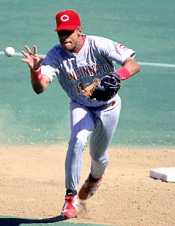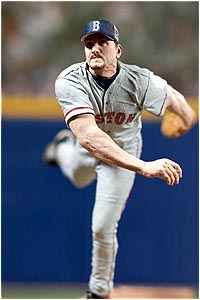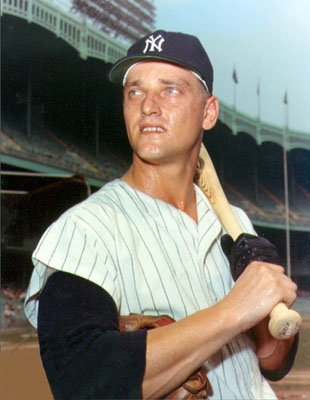On Monday, Cincinnati Reds shortstop Barry Larkin announced his retirement. Larkin is 40 years old and had played a full season only once since 1999, due to age and injuries. He had looked washed up after 2002, having hit only .245 with seven home runs in over 500 at-bats that season. But desiring to justify the $9 million annual salary he was given after the 2001 season, he fought his age and bounced back nicely with two solid, if truncated, seasons to end his career, posting a respectable OPS (~750) in parts of the last two seasons.
Still, it was clear to everyone, except perhaps Barry himself, that Larkin was not in the plans for the 2005 Reds. Larkin certainly wanted to be a contributor to Cincinnati's plans for this season, but either he was asking too much money or the Reds figured that he would be taking up space on the roster that would be better spent on, well, somebody. For something like a $500,000 contract, he could have been useful as a platoon player, but they've got three shortstops under the age of 24 on the roster, and they want to see if any of them stands a chance of being something next year, other than 25.
None of them looks like a good bet: Felipe Lopez has over 1000 major league plate appearances over parts of four seasons, and has hit .235/.309/.379 in them. His minor league record is also unimpressive, showing a (very) little power, a little speed, and almost no plate discipline at all. Ditto for Ray Olmedo, except that he's not even as good as Lopez. The third part of the trio is Anderson Machado, who is roughly the same type of player, but with more speed, more patience, and less of everything else. Unfortunately, Machado will not be part of the running, after having had knee surgery, leaving these two to compete with Rich Aurilia, who at least used to be good. As they say in France: When you've got three shortstops, you've got no shortstop. On the other hand, by signing Joe Randa to play 3B, they may get Ryan Freel more playing time at short, though the plan for the future is not yet clear. But this column isn't about the future: It's about the past. Sort of.
How sad it is that an icon like Barry Larkin should see his career end so that the Reds can waste their energies on players such as these. Thankfully, Larkin will most likely not be primarily remembered as "the Guy who Played Shortstop for the Reds Before Eddie Langenpoop". A Cincinnati native who grew up to play more games for his hometown team than all but four other players in history, Larkin was more than just an icon in Ohio. He was a baseball icon, a symbol of the American dream, fulfilling every kids fantasy, to grow up and become their own town's hero. But nostalgia alone doesn't get you into the Hall of Fame. Accomplishments do.
Barry at bat 
And Barry Larkin has got an accomplishment or two. He won a World Series in 1990, with his Reds sweeping the heavily-favored, heavily-medicated Oakland Athletics, the first championship for Cincinnati since 1976. He also won the 1995 NL MVP award as he helped the Reds to a division title, though they were swept by the eventual World Champion Atlanta Braves. The following year, Larkin became the first infielder to join the 30-30 Club (homers and steals), though he finished a distant 12th in the MVP voting, as the Reds' 81-81 record dragged him down. Larkin won three Gold Gloves at shortstop (1994-96) as well, and probably deserved the two that Ozzie Smith won in 1990 and 1991.
These items, while making some nice padding for his resume, are only small aspects of Larkin's career. His statistical accomplishments must also be considered, both in the context of his peers and in that of History. First, History:
Before I start this section, let me thank Lee Sinins, whose wonderful Sabermetric Baseball Encyclopedia is a tool no seamhead should be without. All of these stats were easily found with it. I used a cutoff of 5000
Career Average Rankings (5000 PA)
AVG OBP SLG OPS
12 9 10 9
These are Larkin's career rankings among shortstops with at least 5000 career plate appearances. (If we bump up the requirement to 6000 or 7000, it mostly eliminates people who are still playing, Like Derek Jeter and Alex Rodriguez. As Larkin will no doubt be compared to these players when the baseball writers are considering his candidacy for Cooperstown, I kept them in as well.) Except for Ed McKean, who played from 1887-1899, and Vern Stephens, the players ahead of Larkin on these four lists are either already in the Hall of Fame, will be elected soon (Cal Ripken) or are likely eventual Hall members still playing (Jeter and A-Rod). That's pretty good company, even though he doesn't get much above the top ten.
Compilation Stats
H 2B SB XBH HR RBI Runs
7 4 10 4 5 12 6
Larkin does a little better in these categories. He played for 19 seasons and therefore had plenty of time to rack up these sorts of numbers. The only significant category in which he's not in the top ten is RBI, and Larkin batted #3, #4 or #5 in the lineup for only about a third of his career, so it's hard to hold that against him. Today's dynamos notwithstanding, shortstops have traditionally been relatively light hitters. Nevertheless, Larkin was clearly among the best of these, if only due to his relative longevity. A lot of shortstops (like Ripken and A-Rod) get moved to third base or somewhere else (like Ernie Banks), whereas Larkin was able to remain at short his entire career. That's got to be worth something.
Sabermetric Stats
OWP TA RCAA RCAP RC RC/G
8 7 4 3 5 12
These stats bear some explanation:
OWP is Offensive Winning Percentage, a rough measure of a players worth that answers the question of "How much would a team of nine of these guys win, given average pitching and defense?" I know, it's kind of a dumb question, since that could never happen, but it does offer us a means of evaluating a player's hitting contributions without the effect of his actual team(s). Larkin ranks 8th all-time, behind only Honus Wagner, Arky Vaughan, Alex Rodriguez, Ernie Banks, Derek Jeter, George Davis, and Lou Boudreau. All of these are either in the Hall of Fame or probably will be, as long as they don't get hit by a bus tomorrow. Actually, maybe even if they do.
TA stands for Total Average, a measure that Total Baseball magazine came up with a few years ago, back when it still existed. This essentially tells you how likely, on average, a player was to advance a base by any possible means. It helps to compensate for players with different skill sets. Again, it's Jeter, A-Rod, and four Cooperstown Cronies in front of him.
RCAA and RCAP are Lee Sinins' own stats, Runs Created above Average and Runs Created Above Position. Honus Wagner and Arky Vaughan are ahead of him on both lists, and A-Rod is ahead of him on the RCAA but not RCAP, as the average shortstop was a better hitter during most of A-Rod's career than during the earlier part of Larkin's.
RC is just Runs Created, which gives an idea of how many runs Larkin was responsible for over the course of his career. Hall of Famers Wagner and Luke Appling, future HoF'er Cal Ripken, and Bill Dahlen, a Dead-Ball Era player who had about 1000 more career plate appearances than Larkin, are the only ones ahead of him on this list.
RC/G is Runs Created per Game, which equalizes for playing career length. Of the 11 players ahead of Larkin, six are already in the Hall, and two more probably will be (again, the left side of the Yankees' infield). Bill Dahlen, Ed McKean and Jack Glasscock are the other three, and their 19th century careers were all very good. Besides this, Larkin ranks ahead of Hall of Famers Lou Boudreau, George Davis, Travis Jackson and (eventually) Cal Ripken.
So, as you might expect, seamheads like me see a lot to like in Barry Larkin's career. Speaking of seamheads, there are two more potential stats that we should seriously consider as we examine Larkin's career: Bill James' Win Shares and Baseball Prospectus' Wins Above Replacement Player, adjusted for all-time. Let's take the second part first, like the guy in Quiz Show, except without all the lying.
Baseball Prospectus has come up with a means of evaluating how many Wins a player was worth over a replacement level player, that is, someone who might be readily available on some AAA farm team to step in and hit .260 with 17 homers and 40 walks, or something like that. "Replacement Level", of course, changes for the position. A shortstop's replacement isn't expected to hit as well as a firstbaseman, for example.
Name WARP3
Honus Wagner* 180.7
Cal Ripken 162.5
Robin Yount* 129.5
Ozzie Smith* 127.7
Bill Dahlen 119.0
Arky Vaughan* 118.8
Ernie Banks* 117.3
Barry Larkin 116.8
Luke Appling* 116.4
Alan Trammell 114.0
George Davis* 111.3
Bobby Wallace* 106.6
Alex Rodriguez 104.9
Joe Cronin* 104.8
Lou Boudreau* 101.4
Pee Wee Reese* 96.6
Luis Aparicio* 90.7
Rabbit Maranville* 88.7
Joe Sewell* 87.1
Omar Vizquel 81.9
Vern Stephens 78.5
Monte Ward* 78.0
Dave Bancroft* 76.6
Phil Rizutto* 73.6
Joe Tinker* 72.6
Derek Jeter 68.1
Travis Jackson* 57.1
Ed McKean 46.3
That's a pretty good list.
These are the players' career WARP3 numbers, adjusted for all-time, that is, for a 162-game schedule. The players with an asterisk (*) are not denoted in this manner because they were on the Juice, at least as far as we know. Those players are currently members of the Hall of Fame. Players in italics are not necessarily from Italy, but are either still active or recently retired and therefore not eligible for the Hall, yet.
Ripken will easily get in on the 2006 ballott, and Alex Rodriguez would get in if he retired tomorrow. Robin Yount and Ernie Banks both started their careers as shortstops but moved to another position and actually spent more time at that position throughout their careers than they did at short, so technically, they shouldn't even be a part of this study. Without them, that leaves Barry Larkin as the #5 shortstop in history, ahead of more than a dozen other shortstops already in the Hall. He's behind only Honus Wagner, Cal Ripken, Ozzie Smith (whose value is comprised mostly of his defensive contributions), Arky Vaughan and Bill Dahlen. And Dahlen is probably a little underrated, since he played in the Dead Ball Era, and persistently found himself overshadowed by his future Hall of Fame teammates.

Barry Fielding

The last metric, and perhaps the best, is Win Shares. This list is the top 20 players whose value was largely defined by their play as a shortstop. Again, Ripken, Yount, banks and others had significant portions of their careers as something other than a shortstop, but their greatest value was tallied at that position.
Honus Wagner 656
Cal Ripken 427
Robin Yount 420
Monte Ward 410
George Davis 398
Bill Dahlen 393
Luke Appling 376
Arky Vaughan 356
Barry Larkin 346
Bobby Wallace 345
Joe Cronin 333
Ernie Banks 332
Ozzie Smith 327
Alan Trammell 318
Pee Wee Reese 314
R. Maranville 302
Luis Aparicio 293
Alex Rodriguez 282
Lou Boudreau 277
Joe Sewell 277
I only used the top 20, which really shouldn't include Monte Ward, a 19th century player/pioneer who also pitched very well for several seasons, and therefore picks up a lot of Win Shares that way. Rodriguez, as well as Jeter and Nomar, will move up on this list, and A-Rod will certainly eclipse him with two more good seasons. Jeter currently has only 209 WS, so it will take 4-6 years for him to surpass Larkin, if he ever does. So without Ward, and for that matter without Yount, Larkin is one of the half dozen or so best shortstops ever, and is easily more valuable than a dozen or so shortstops already in the Hall.
That's pretty good company, and hopefully the onslaught of impressive offensive shortstops will not deter the baseball writers from recognizing Barry as a deserving member, when his time comes.
But when will Bill Dahlen get some love?






